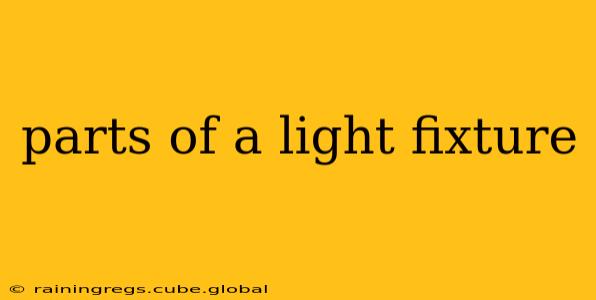Understanding the various parts of a light fixture is crucial, whether you're a seasoned electrician, a DIY enthusiast tackling a home improvement project, or simply curious about how these everyday objects function. This guide breaks down the key components, explaining their roles and how they work together to illuminate our spaces. We'll also address some frequently asked questions to provide a comprehensive overview of light fixture anatomy.
What are the Main Parts of a Light Fixture?
A typical light fixture, regardless of its style or complexity, comprises several fundamental parts:
-
The Housing: This is the main body of the fixture, often made of metal, plastic, or glass, providing structural support and protection for the internal components. Its design contributes significantly to the fixture's aesthetic appeal.
-
The Socket: This is the crucial component where the light bulb is inserted and connected to the electrical circuit. Different sockets accommodate various bulb types (e.g., Edison screw, bayonet mount). The socket's material and design impact its durability and compatibility.
-
The Wiring: The wiring system connects the socket to the power source, allowing electricity to flow to the bulb. Proper wiring is essential for safety and functionality, adhering to local electrical codes.
-
The Lamp or Bulb: This is the light-producing element, converting electrical energy into light. Different bulb types (incandescent, fluorescent, LED) offer varying light output, energy efficiency, and lifespan.
-
The Mounting Bracket: This part secures the fixture to the ceiling or wall, providing stability and support. Different mounting brackets are used for various fixture types and installation methods.
-
The Canopy (or Cover Plate): This decorative cover conceals the wiring and mounting hardware, enhancing the fixture's aesthetic appeal and providing a finished look. Materials vary widely, from simple metal to ornate glass.
What are the different types of light fixture sockets?
Light fixture sockets come in various types, designed to accommodate different bulb bases. The most common types include:
-
Edison Screw (E26 and E27): These are the standard screw-in sockets found in most household fixtures in North America and other parts of the world. E26 is used in the US, while E27 is more common in Europe.
-
Bayonet Mount (B22): These sockets use a bayonet system for connection, often seen in Europe and other regions.
-
GU10 (Bi-Pin): This type of socket is commonly used for low-voltage halogen and LED spotlights.
The correct socket type is essential for ensuring the bulb fits securely and functions correctly. Using an incompatible bulb can damage the socket or create a fire hazard.
What are the different types of light fixture housings?
Light fixture housings are available in numerous materials and designs, influencing both functionality and aesthetics. Common materials include:
-
Metal (Steel, Brass, Aluminum): Metal housings provide durability and heat dissipation, making them suitable for various lighting applications.
-
Plastic: Plastic housings are lightweight and often more affordable, but they may not be as durable or heat-resistant as metal housings.
-
Glass: Glass housings offer a decorative element, often used for pendant lights or chandeliers.
The choice of housing material depends on factors like style, durability requirements, and the intended environment.
How do I identify the parts of my light fixture?
Identifying the parts of your light fixture is often straightforward. A visual inspection combined with a little research can usually pinpoint each component. If you're unsure, carefully examine the fixture's structure, referring to the information above to match the components to their descriptions. Consult a qualified electrician if you're uncomfortable performing any inspection or maintenance yourself.
What tools are needed to assemble a light fixture?
Assembling a light fixture usually requires basic tools, but the specifics depend on the fixture's design and complexity. Generally, you will likely need:
- Screwdrivers (Phillips and flathead): For securing screws and attaching various components.
- Wire strippers/cutters: To prepare the electrical wires for connection.
- Voltage tester: To ensure the power is off before working on the fixture. This is crucial for safety.
- Measuring tape: For accurate measurements during installation.
This comprehensive guide provides a solid understanding of light fixture parts. Remember that always prioritizing safety is paramount when working with electrical components. If in doubt, consult a qualified electrician.
